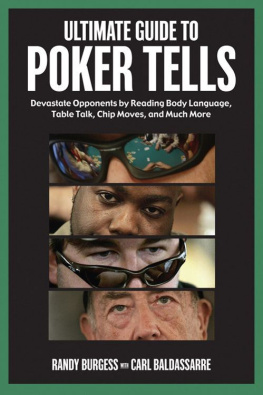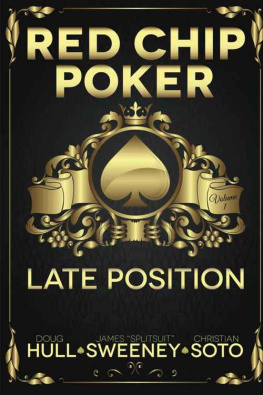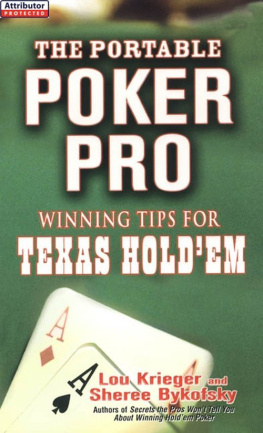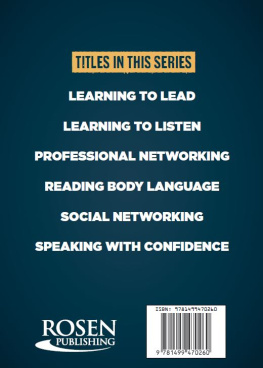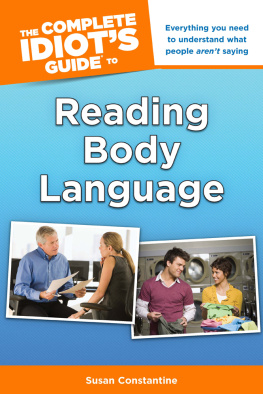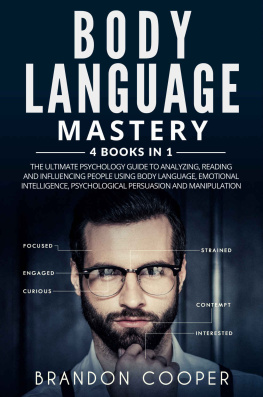Randy Burgess - Ultimate Guide to Poker Tells: Devastate Opponents by Reading Body Language, Table Talk, Chip Moves, and Much More
Here you can read online Randy Burgess - Ultimate Guide to Poker Tells: Devastate Opponents by Reading Body Language, Table Talk, Chip Moves, and Much More full text of the book (entire story) in english for free. Download pdf and epub, get meaning, cover and reviews about this ebook. year: 2006, publisher: Triumph Books, genre: Romance novel. Description of the work, (preface) as well as reviews are available. Best literature library LitArk.com created for fans of good reading and offers a wide selection of genres:
Romance novel
Science fiction
Adventure
Detective
Science
History
Home and family
Prose
Art
Politics
Computer
Non-fiction
Religion
Business
Children
Humor
Choose a favorite category and find really read worthwhile books. Enjoy immersion in the world of imagination, feel the emotions of the characters or learn something new for yourself, make an fascinating discovery.
- Book:Ultimate Guide to Poker Tells: Devastate Opponents by Reading Body Language, Table Talk, Chip Moves, and Much More
- Author:
- Publisher:Triumph Books
- Genre:
- Year:2006
- Rating:4 / 5
- Favourites:Add to favourites
- Your mark:
- 80
- 1
- 2
- 3
- 4
- 5
Ultimate Guide to Poker Tells: Devastate Opponents by Reading Body Language, Table Talk, Chip Moves, and Much More: summary, description and annotation
We offer to read an annotation, description, summary or preface (depends on what the author of the book "Ultimate Guide to Poker Tells: Devastate Opponents by Reading Body Language, Table Talk, Chip Moves, and Much More" wrote himself). If you haven't found the necessary information about the book — write in the comments, we will try to find it.
Randy Burgess: author's other books
Who wrote Ultimate Guide to Poker Tells: Devastate Opponents by Reading Body Language, Table Talk, Chip Moves, and Much More? Find out the surname, the name of the author of the book and a list of all author's works by series.
Ultimate Guide to Poker Tells: Devastate Opponents by Reading Body Language, Table Talk, Chip Moves, and Much More — read online for free the complete book (whole text) full work
Below is the text of the book, divided by pages. System saving the place of the last page read, allows you to conveniently read the book "Ultimate Guide to Poker Tells: Devastate Opponents by Reading Body Language, Table Talk, Chip Moves, and Much More" online for free, without having to search again every time where you left off. Put a bookmark, and you can go to the page where you finished reading at any time.
Font size:
Interval:
Bookmark:

Contents
Acknowledgments
To the Boiceville school, for teaching me what poker is all about: Martha, Jimmy, Doug, Slide, Barry, Michael, and Robert. And to Carl, for his editing savvy and moral support.
Randy Burgess
To Randy, who thinks he knows my tells. And to Marian, who does.
Carl Baldassarre
The authors also would like to thank Adam Alster, Cary Cheung, Kenneth Cheung, Melissa Foerstman, Robert Goldman, Paul Kesselman, William Lui, Brian McNamee, Anthony J. Piantieri, and David Ryzhik for taking time away from playing to appear in the poker quiz photos. And special thanks to Brian for acting as our photographer.
Introduction
Do you need this book? See if you recognize yourself in one of the following descriptions.
Youre a casino regular, concentrating on playing tight but aggressively. Youve read all the right books, you know how to calculate your odds and outs, but youre still barely staying ahead of the rake. A good player whos been fairly friendly has suggested you need to develop a better feel. What the heck does that mean?
Youve been playing in a small no-limit cash game where some of the players take insane risks. These crazy players sometimes have big nights, but they often go broke. Sadly, youre not the one who gets their money. Instead, it usually goes to a small number of regulars who seem to have a sixth sense for when to call an all-in bet with no more than middle pair, or when to make a big laydown. How do they do that, you wonder, and how can you learn?
Youve always been an Internet player, but then last month a buddy got you into an underground club near your office. Now youve got serious information overload. All the loose chatter, facial tics, strange hand gestures, and attempts at gamesmanship that seem to verge on cheatingwhat should you pay attention to and what should you ignore?
Youre struggling to keep your head above water in a small-stakes home game, where the specialty of the house is various forms of high-low declare. The games biggest winner is a disheveled former pilot with a bad rotator cuff, who seems to have mastered the art of declaring whichever way nobody else is going. He calls it sliding, but cant explain how its done. Cantor wont.
In every one of these cases, learning how to recognize and interpret tells can help your gamesometimes a little, sometimes a lot. Youll benefit the most if you already play fundamentally sound poker, with at least some ability to read betting patterns. Youll benefit the least if you play like a train wreck, totally disregarding hand values and pot odds. If youre a novice, of course, you first need to learn proper strategy and gain experience at the tablesbut even at this early stage, a knowledge of tells can be a valuable part of your basic training.
This book is perhaps the most complete resource available today for learning about tells. To make sure we didnt leave anything out, we not only worked from our own experience but ransacked poker literature for tips from such top players/authors as Bob Ciaffone, Doyle Brunson, Phil Hellmuth Jr., Dan Harrington, and T. J. Cloutier.
Weve also included a special focus on todays most popular forms of poker: limit and no-limit holdem. By contrast, the only other book devoted solely to tells, the otherwise classic Book of Tells , by poker legend Mike Caro, focuses mostly on draw pokera game thats faded so thoroughly from the scene youll probably never play it. (If youre not a holdem player, dont worry; we also cover other common games, including seven-card stud, Omaha Hi-Low, and more.)
This book makes clear what many books do not, but what every top player knowsthat tells are valuable only in context, not in isolation. Reading a tell is like intercepting a coded message in wartime: even if you break the code, you still need to have a good idea of the enemys strength, concerns, and plans in order for the message to make sense and affect what you do next.
With all of the books out there on poker psychology, theres been surprisingly little written on how people learn to interpret nonverbal signalsnot just at the poker table, but in life in general. Among other things, well look at how certain highly trained police officers seem able to detect guilt or innocence in a flash, and, similarly, how some Buddhist monks can instantly detect concealed emotions such as fear or anger. Examples such as these lead us to methods for training your poker intuition that you might not have considered otherwise.
The plan of this book is simple. In the first couple of chapters, well lay a foundation by analyzing the nature of tells in general. Next, well go through a catalog of tells for specific games, since tells often vary from game to game. Finally, in the last few chapters, well discuss ways to improve your reading abilities, even as you strive to avoid giving off tells yourself. Well also address an important related subjecthow to protect yourself against players who pretend to be broadcasting fake tells, but who are really crossing the line into angle-shooting and other unethical attempts at manipulation.
We also include a couple of appendices: a glossary to cover any poker terms youre not familiar with, plus a list of further resources for learning more about tells and about poker in general.
Tells may seem simple at first, but the more you learn about them, the more you realize how pervasive they are in any setting but online. The ability to gauge a players nonverbal attitude and intentions is not a substitute for technical knowledge, but it is a helpful addition to your gameand it sure makes playing poker fun. And even for the pros, having fun is important. We hope you have fun reading this book, too.
To be fair, Caro does include many classic holdem and stud tells, such as the big stall with a big hand in no-limit. (See chapter 5, Tells in No-Limit Holdem.)
1. How Important Are Tells in Poker?
Whats a tell? Following are a few short examples.
In his prime, Doyle Brunson was perhaps the most feared no-limit holdem player alive. But for a brief while he had a habit that would have made him easy prey for a keen-eyed opponent: when he was betting a real hand, he would count his chips before betting them; when he was bluffing, he would push his chips forward without counting them. Brunsons friend and fellow professional Amarillo Slim finally let him in on the secret.
The most famous tell that never happened has to be Teddy KGBs cracking open of an Oreo cookie whenever he has a monster hand. Of course, you already know thisunless youre one of the 14 poker players on the planet whove never seen the movie Rounders , starring Matt Damon as the hero, Mike McDermott, and John Malkovich as the evil Teddy. In their climactic head-up holdem duel, Mike finally catches on to the cookie tell and uses the knowledge to not only avoid losing his entire stack against Teddys baby straight, but to put Teddy on tilt and turn the match around.
Heres a tell of the sort Ive witnessed time and time again, in one form or another. Again the game is holdem, but instead of high-stakes drama, its a $4/$8 limit game at a local club. Three average players are going through the motions: two early limpers versus a raiser on the button. The flop comes A - T - - ; both limpers check, the button bets, and only the first limper calls. The turn brings a second Tenand now the remaining limper flips up the corners of his hole cards to glance at them before again saying check in a voice that ever-so-slightly mixes boredom with disgust. The button bets and lo, the limper check-raises! The button is dismayed, but he shouldnt have been: there was no reason whatsoever for the limper to check his hole cards when the second Ten hitunless he was doing a very bad acting job. If that werent enough, the extra-bored voice should have been an additional tip-off.
Next pageFont size:
Interval:
Bookmark:
Similar books «Ultimate Guide to Poker Tells: Devastate Opponents by Reading Body Language, Table Talk, Chip Moves, and Much More»
Look at similar books to Ultimate Guide to Poker Tells: Devastate Opponents by Reading Body Language, Table Talk, Chip Moves, and Much More. We have selected literature similar in name and meaning in the hope of providing readers with more options to find new, interesting, not yet read works.
Discussion, reviews of the book Ultimate Guide to Poker Tells: Devastate Opponents by Reading Body Language, Table Talk, Chip Moves, and Much More and just readers' own opinions. Leave your comments, write what you think about the work, its meaning or the main characters. Specify what exactly you liked and what you didn't like, and why you think so.

